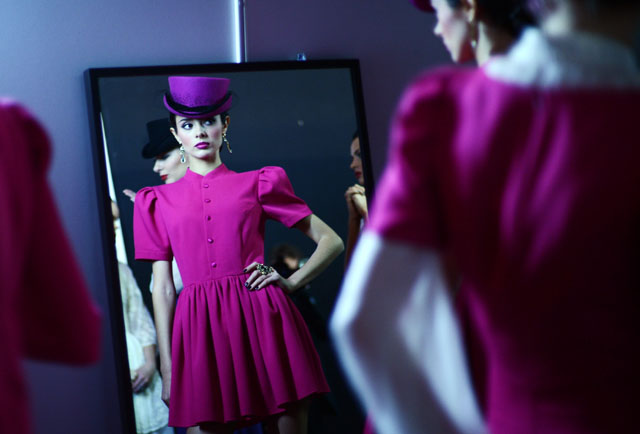“You are going to have to [look] sooner or later, our world is full of reflective surfaces.” Harling, R. (1988) Steel Magnolias, 2.1:18.
 I laughed out loud reading Barbara’s recent post and the public speaking drinking game! What a hilarious response to seeing herself during a videotaping extravaganza. I also happened to get the telephone debrief, which was equally comical, as Barbara detailed the myriad complaints of what a disaster it was, i.e., “There wasn’t even a mirror at the studio for me to check how I looked!” She was entirely dependent upon the “mirror” that was the videographer. And, if you know the power, confidence and energy that is Barbara Roche (check our her book), you too would overlook the hair out of place or a repeating word that the videographer never even noticed. But there it is, the disorientation we experience seeing ourselves “live.”
I laughed out loud reading Barbara’s recent post and the public speaking drinking game! What a hilarious response to seeing herself during a videotaping extravaganza. I also happened to get the telephone debrief, which was equally comical, as Barbara detailed the myriad complaints of what a disaster it was, i.e., “There wasn’t even a mirror at the studio for me to check how I looked!” She was entirely dependent upon the “mirror” that was the videographer. And, if you know the power, confidence and energy that is Barbara Roche (check our her book), you too would overlook the hair out of place or a repeating word that the videographer never even noticed. But there it is, the disorientation we experience seeing ourselves “live.”
This jolt can be so dramatic, that in our early SpeakWell Partner days, we didn’t tape our clients. I still assert that a trusted advisor can absolutely tell you that you have hit the mark and spare you the challenge of watching yourself on video. When you are fully prepared for your presentation, you know it, videotape or no videotape. But more often than not, we now use the taping as another tool for most clients, usually toward the end of our working sessions. At the right time, in the right place, it is tremendously valuable.
I believe that most people think the aversion to being taped is just a vanity issue. But it’s so much more than that and there are documented and practical reasons explaining why we are all so disoriented. Understanding these simple issues might help you to overcome your resistance to being taped or using the video tool in the future.
Reverse Mirror Effect: Each morning and evening what I see staring back at me is my image in reverse. No news there. But this repeated exposure to myself (“mere exposure hypothesis”) means I simply am accustomed to (and hence prefer) the mirror image I see. The devil I know is my face in reverse. I carry this “picture” in my head, and reality is “jarring”. Duncan Davidson TEDX Talk.
We Don’t Like Hearing Our Voices Either: Sound can enter our ears in one of two ways: air-conducted or bone-conducted. Air –conducted sound travels through the eardrums to the cochlea and is converted to nerve impulses interpreted in the brain. With bone-conducted, sound vibrations from the vocal cords reach the cochlea and, thanks to our skulls, lower the frequency of the vibration en route. Which is why we think we have a lower pitch than we do, we hear ourselves that way. Our voice is higher pitched than what we hear. It is a jarring experience. Except to all the people we work, play and live with.
Barring what I wrote above, the truth is that we have seen ourselves in a lifetime of snapshots and photographs. “Good angle? – save and post”, “Awkward shot, – delete immediately!” But it is slightly surreal to watch and hear ourselves, from our interior, intimate perception to this recorded person manifested in sound, movement, tics and quirks that looks like me, sounds like me and yet….., “it’s so weird!”
Next time you’re watching yourself on tape, remember that your dissonant experience is not unique, there are good reasons for it, and try not to throw the baby out with the bath water. There is so much good information to capture and learn from.
– Charlotte

